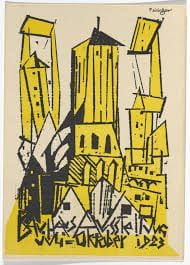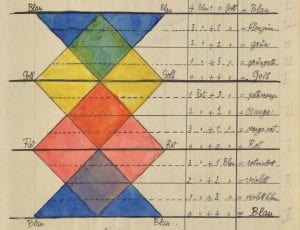As a group, we chose the topic ‘Bauhaus and the New Typography’. In our group of 4, we decided to each research and cover a certain section within this topic. My section was researching the students experience, the teachers and what they taught at the Bauhaus.
My Research
Students experience at the Bauhaus
At the Bauhaus, they believed in the unity of the artist and the craftsman. Students would take a 1-year preliminary course which covered every subject. It involved painting and elementary experiments with form. They would then do three years of workshop training by one Craftsman and one artist in a subject they want to specialize in. Some of the subjects included: carpentry, fine art, printing, photography and advertising. There was such a wide variety because Walter Gropius wanted to dissolve the differences between fine art and applied art. Some students studied architecture in theory and in practice, working on the construction of buildings.
Students were in contact with some of the most important practicing artists and designers of the time. The school brought together students of different ages and nationalities into a community. In fact, the creative atmosphere at Bauhaus attracted students from over 29 countries. It also became known for its masquerade’s and experimental light and music evenings.
One of the students was Ludwig Hirschfeld-Mack and he was a student from 1919-1925. He created reflective light plays using circles, triangles and squares cut from stencils which moved to music. This new way of teaching and creative curriculum attracted many teaching staff.
Teachers
Lyonel Feininger and Johannes Itten were two of the first teachers appointed to the Bauhaus school in 1919.
Lyonel Feininger: He became master of the printmaking workshop. He also designed the cover of the Bauhaus manifesto in 1919 which was a woodcut of a cathedral. He had a passion for architecture and would paint buildings and cityscapes. He was inspired by cubism and futurism. He taught at the Bauhaus until it closed in 1932.
Johannes Itten: Taught from 1919-1923. He was a huge influence in the early years of Bauhaus. He developed the preliminary course and was a master in many of the workshops. He is most well known for teaching colour theory. He taught it using a colour sphere which showed the relationship between colours. He was also one of the first to associate colours with emotion, how we perceive colour and the impact it has on our mood.
Paul Klee: Throughout his time at the Bauhaus, he taught in many workshops. Some of these include: Bookbinding, metal and glass painting workshops. He taught a design and form theory class as part of the preliminary course. Online, we can still find some of his original sketches on form and design theory.
Wassily Kandinsky: He was head of the painting workshop. He also taught a well known course on colour. He had developed a new way of teaching colour by analysing the relationship between point, line and plane. He also taught about the psychology of the perception of colour.
Oskar Schlemmer: Joined the Bauhaus in 1921 where he taught stone and wood sculpture workshops. He was also in charge of the theater workshop where he would put on many stage productions. These would involve dancers in geometric style costumes making mathematically inspired moves.
Bauhaus Typography
Typography was taught at the Bauhaus school. They were strong advocates of the sans-serif type. Its simplified geometric form was more appealing than the German standard of black-letter typography which was highly decorated.
Characteristics of the typography
- Effective in conveying the message of the design
- Balance layout
- Geometric shapes
- Vibrant colours
- San serif in upper and lower case are simple but strong
The legacy of the school’s typography has been carried on in books, album covers, political posters, signs etc.







